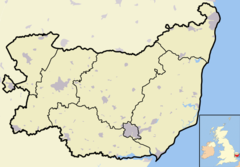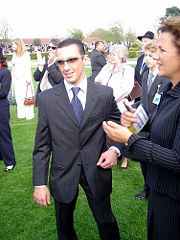Newmarket, Suffolk
2008/9 Schools Wikipedia Selection. Related subjects: British Cities; Great Britain
| Newmarket | |
|
Newmarket shown within Suffolk |
|
| Population | 14,995 (2001 Census) |
|---|---|
| OS grid reference | |
| District | Forest Heath |
| Shire county | Suffolk |
| Region | East |
| Constituent country | England |
| Sovereign state | United Kingdom |
| Post town | NEWMARKET |
| Postcode district | CB8 |
| Dialling code | 01638 |
| Police | Suffolk |
| Fire | Suffolk |
| Ambulance | East of England |
| European Parliament | East of England |
| UK Parliament | West Suffolk |
| List of places: UK • England • Suffolk | |
Coordinates:
Newmarket is a market town in the English county of Suffolk, approximately 65 miles (105 kilometres) north of London, which has become famous because of its connection with race horses and thoroughbred horse racing at Newmarket Racecourse. It is the largest racehorse training centre in Britain, and home to several horseracing institutions. Nine of the UK's 31 Group 1 flat races are held at Newmarket, the same number as at Ascot Racecourse.
Racing
Racing at Newmarket has been dated as far back as 1174, making it the earliest known racing venue of post-classical times. King James I (reigned 1603 - 1625) greatly increased the popularity of horse racing there, and King Charles I followed this by inaugurating the first cup race in 1634. The Jockey Club's clubhouse is in Newmarket, though its administration is based in London. In 1967 Queen Elizabeth II opened The National Stud, a breeding centre for thoroughbred horses. The town is also home to Tattersalls, the famous bloodstock auctioneers whose sales are attended by big names in the racing business. The town is home to the National Horseracing Museum and an Equine Centre for horse health.
The town has special horse routes so the horses can reach the gallops safely from the many training establishments occupied by top trainers. More than 2,500 race horses inhabit Newmarket. By comparison, the human population is of the order of 15,000 and it is estimated that one in four jobs are connected to horseracing in one way or another. Newmarket has 3 main sections of Heath, all of which are used to train the racehorses on. "Racecourse side" is located next to the Rowley Mile Racecourse and is a predominately flat area. "Warren Hill" overlooks the town and consists of 3 all weather canters and a multitude of grass canters. "Bury Side" is the name given to the area located near the Bury Road and the Railway Line. These areas and the surrounding heath is chalk downland and has special birds and animals only suited to this terrain. It is also a very historical area with the remains of 6th century living to be found. This hill is part of the chalk formation the Newmarket Ridge.
Most of the Newmarket-based racing stables are situated in the centre of the town, where they can easily access the gallops. Outside the town the land-use is dominated by thoroughbred breeding, studs occupying large areas in every direction. Around 70 licensed trainers and more than 60 stud farms operate in and around Newmarket.Dalham Hall Stud (the headquarters of Darley), Cheveley Park Stud (which local lore claims was once owned by King Canute), and Banstead Manor Stud (Headquarters of Juddmonte Farms) are well-known examples all which can be found in the village of Cheveley, three miles from Newmarket.
The town has two race courses situated on Newmarket Heath, these are the Rowley Mile and the July Course. The two courses are separated by the Devil's Dyke. This large earthwork starts in neighbouring Woodditton (sometimes spelt as Wood Ditton) and ends in Reach, a distance of over 8 miles.
Transport
Newmarket railway station is on the Cambridge - Bury St. Edmunds - Ipswich rail line, formerly belonging to the Great Eastern Railway (later part of the LNER). Newmarket's first railway was a line built by the Newmarket and Chesterford Railway Company and opened in 1848 (known as the "Newmarket Railway"). It branched off the London - Cambridge main line at Great Chesterford and ran about 15 miles north eastwards. There was an attractive terminus in Newmarket, with intermediate stations at Bourne Bridge, Balsham Road and Six Mile Bottom.
Three years later the first nine miles or so of this line, the stretch from Great Chesterford to Six Mile Bottom, was superseded by a more viable section linking Six Mile Bottom directly with Cambridge, and so the Great Chesterford - Six Mile Bottom section closed in 1851, one of the earliest closures in British railway history (the former Bourne Bridge station is believed to have been partly incorporated into a public house just across the road from a station opened later on another line - Pampisford, on the now-closed Cambridge - Haverhill - Sudbury route). With the development of other rail lines the Newmarket terminus was replaced by the present through station in 1902; it was used as a goods station until 1967 and demolished in 1980.
A short distance to the north east is the 1,100 yard Warren Hill tunnel. North of the tunnel, a separate station, Warren Hill, was built for raceday use.
In late 2006, Newmarket introduced a Park and Ride service running from Studlands industrial estate to the town centre, whilst at the same time parking charges were introduced to the town.
Geography
The area of Suffolk containing Newmarket is nearly an exclave, with only a narrow strip of territory linking it to the rest of the county. Historically the town was split with one parish - St Mary - in Suffolk, and the other - All Saints - in Cambridgeshire. The Local Government Act 1888 made the entirety of Newmarket urban sanitary district part of the administrative county of West Suffolk.
The 1972 Local Government Bill as originally proposed would have transferred the town (and Haverhill) to Cambridgeshire. The Local Government Commission for England had suggested in the 1960s that the border around Newmarket also be altered, in West Suffolk's favour. Newmarket Urban District Council supported the move to Cambridgeshire, but ultimately the government decided to withdraw this proposal and keep the existing boundary, despite intense lobbying from the UDC.
Miscellany
- From 1808 to 1814 Newmarket hosted a station in the shutter telegraph chain which connected the Admiralty in London to its naval ships in the port of Great Yarmouth.
- According to "The Strange Laws of Old England" by historian and author Nigel Cawthorne, it was against the law to blow one's nose in the street and a person or persons going about the street with a head cold or distemper was liable to a fine. This law was introduced to protect not the Newmarket citizens but the vast racing stock.
- Newmarket has an amateur football team called Newmarket Town. In recent time the club has had a successful FA Vase run, reaching the quarter finals in 2005/06.
- Newmarket has an amateur jousting team which in 2001 became the first such team to win successive Eastern League titles.
- Famous residents of Newmarket include jockey Frankie Dettori and trainer Sir Michael Stoute.
Twin towns
Newmarket has three sister cities, as designated by Sister Cities International:
 Lexington, Kentucky, USA (Note: the towns are only twinned through horse-racing, and beer servery)
Lexington, Kentucky, USA (Note: the towns are only twinned through horse-racing, and beer servery) Maisons-Laffitte, France
Maisons-Laffitte, France Le Mesnil-le-Roi, France
Le Mesnil-le-Roi, France Welshpool, Wales
Welshpool, Wales Gowerton, Wales
Gowerton, Wales

